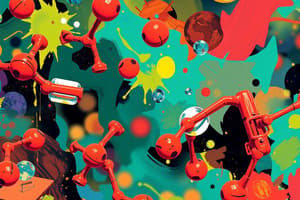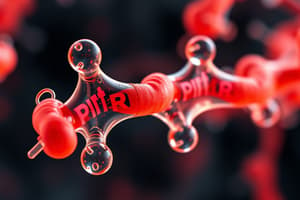Podcast
Questions and Answers
What is the proposed benefit of embracing small doses of pain?
What is the proposed benefit of embracing small doses of pain?
- It resets our tolerance to pain. (correct)
- It helps in achieving immediate pleasure.
- It forces us to seek relief through medication.
- It encourages dependence on external sources of happiness.
What alternative to escapism is suggested?
What alternative to escapism is suggested?
- Avoiding all forms of discomfort.
- Seeking pleasure in isolation.
- Engaging in self-indulgent activities.
- Immersing ourselves in the world and finding purpose. (correct)
How can pain exposure affect dopamine release?
How can pain exposure affect dopamine release?
- It increases the reliance on pleasure from other sources.
- It can lead to a dopamine release that lessens reliance on other sources. (correct)
- It stops the brain from experiencing emotional pain.
- It reduces the natural production of dopamine.
What is the main idea of turning towards the world instead of escaping?
What is the main idea of turning towards the world instead of escaping?
What is the effect of voluntarily seeking discomfort, such as through ice water immersion?
What is the effect of voluntarily seeking discomfort, such as through ice water immersion?
What does repeated exposure to a pleasure stimulus lead to in terms of neuroadaptation?
What does repeated exposure to a pleasure stimulus lead to in terms of neuroadaptation?
Which concept refers to the need for greater amounts of a stimulus to achieve the same level of pleasure?
Which concept refers to the need for greater amounts of a stimulus to achieve the same level of pleasure?
What is meant by the term 'limbic capitalism'?
What is meant by the term 'limbic capitalism'?
What role does self-binding play in achieving balance in the dopamine economy?
What role does self-binding play in achieving balance in the dopamine economy?
Why is the cycle of craving and reward often subconscious?
Why is the cycle of craving and reward often subconscious?
What strategy involves intentionally pursuing pain as a means for maintaining balance?
What strategy involves intentionally pursuing pain as a means for maintaining balance?
What is the primary consequence of the 'dopamine economy' on human behavior?
What is the primary consequence of the 'dopamine economy' on human behavior?
Which of the following is NOT a strategy mentioned for achieving balance in the dopamine economy?
Which of the following is NOT a strategy mentioned for achieving balance in the dopamine economy?
What is the primary purpose of practicing radical honesty?
What is the primary purpose of practicing radical honesty?
Which type of self-binding involves setting geographical barriers to limit access to addictive behaviors?
Which type of self-binding involves setting geographical barriers to limit access to addictive behaviors?
How does the pleasure-pain balance affect addiction when experiencing repeated pleasurable activities?
How does the pleasure-pain balance affect addiction when experiencing repeated pleasurable activities?
What is the first step in the dopamine fasting process according to the DOPAMINE acronym?
What is the first step in the dopamine fasting process according to the DOPAMINE acronym?
What distinguishes destructive shame from pro-social shame?
What distinguishes destructive shame from pro-social shame?
What role does modern technology play in compulsive overconsumption?
What role does modern technology play in compulsive overconsumption?
What does the principle of self-binding suggest regarding willpower?
What does the principle of self-binding suggest regarding willpower?
What is the main objective of pressing on the 'pain side' of the pleasure-pain balance?
What is the main objective of pressing on the 'pain side' of the pleasure-pain balance?
What societal effect does radical honesty have on addiction prevention?
What societal effect does radical honesty have on addiction prevention?
What does categorical self-binding emphasize?
What does categorical self-binding emphasize?
Which step of dopamine fasting focuses on gaining insights into the relationship between behaviors and emotions?
Which step of dopamine fasting focuses on gaining insights into the relationship between behaviors and emotions?
What is an expected consequence of habitual dopamine surges in the brain?
What is an expected consequence of habitual dopamine surges in the brain?
What is the outcome of engaging in pro-social shame during recovery?
What is the outcome of engaging in pro-social shame during recovery?
How does dopamine fasting ultimately aim to reset brain function?
How does dopamine fasting ultimately aim to reset brain function?
What is the primary goal of dopamine fasting?
What is the primary goal of dopamine fasting?
Which of the following best describes self-binding?
Which of the following best describes self-binding?
What is an example of categorical self-binding?
What is an example of categorical self-binding?
Which type of shame leads to seeking redemption and guidance?
Which type of shame leads to seeking redemption and guidance?
Radical honesty promotes which of the following?
Radical honesty promotes which of the following?
What is a consequence of increasing access and potency of drugs mentioned in the content?
What is a consequence of increasing access and potency of drugs mentioned in the content?
Which action is described as recognizing the limitations of willpower?
Which action is described as recognizing the limitations of willpower?
What is a potential benefit of abstaining from drug use for at least four weeks?
What is a potential benefit of abstaining from drug use for at least four weeks?
Which form of self-binding involves removing access to addictive substances?
Which form of self-binding involves removing access to addictive substances?
What does the 'plenty' mindset promote according to the discussion on radical honesty?
What does the 'plenty' mindset promote according to the discussion on radical honesty?
What is a critical aspect emphasized in the importance of abstinence?
What is a critical aspect emphasized in the importance of abstinence?
Which of the following would NOT be considered a digital drug?
Which of the following would NOT be considered a digital drug?
What characterizes destructive shame?
What characterizes destructive shame?
What is the primary benefit of mindfulness in relation to substance use?
What is the primary benefit of mindfulness in relation to substance use?
Which statement best captures the essence of family dynamics related to mistakes?
Which statement best captures the essence of family dynamics related to mistakes?
What is a significant danger of compulsive overconsumption in pain-seeking activities?
What is a significant danger of compulsive overconsumption in pain-seeking activities?
Which aspect is emphasized as necessary for recovery from addiction?
Which aspect is emphasized as necessary for recovery from addiction?
What concept does the Stanford Marshmallow Experiment illustrate?
What concept does the Stanford Marshmallow Experiment illustrate?
What is the recommended approach to finding meaning in life after addiction?
What is the recommended approach to finding meaning in life after addiction?
Which factor contributes to the increased addictive nature of modern substances?
Which factor contributes to the increased addictive nature of modern substances?
What does the 'DOPAMINE' Framework emphasize as necessary for addiction treatment?
What does the 'DOPAMINE' Framework emphasize as necessary for addiction treatment?
Which character demonstrates the importance of self-binding as a struggle against addiction?
Which character demonstrates the importance of self-binding as a struggle against addiction?
What is one of the primary challenges in seeking joy through addiction?
What is one of the primary challenges in seeking joy through addiction?
What role does empathy play in the recovery processes mentioned?
What role does empathy play in the recovery processes mentioned?
What happens to individuals who engage in the compulsive seeking of pain without caution?
What happens to individuals who engage in the compulsive seeking of pain without caution?
What does the narrative of Jacob illustrate about addiction?
What does the narrative of Jacob illustrate about addiction?
What is a significant focus of recovery as indicated in the content?
What is a significant focus of recovery as indicated in the content?
Flashcards
Pleasure-Pain Balance
Pleasure-Pain Balance
A homeostatic system where pleasure leads to pain and vice versa.
Neuroadaptation
Neuroadaptation
The brain's adjustment to repeated exposure to pleasure stimuli, reducing initial pleasure and increasing pain response.
Tolerance
Tolerance
The condition where more of a stimulus is needed to achieve the same pleasurable effect.
Craving
Craving
Signup and view all the flashcards
Dopamine Economy
Dopamine Economy
Signup and view all the flashcards
Limbic Capitalism
Limbic Capitalism
Signup and view all the flashcards
Addictive Cycle
Addictive Cycle
Signup and view all the flashcards
Radical Honesty
Radical Honesty
Signup and view all the flashcards
Dopamine Fasting
Dopamine Fasting
Signup and view all the flashcards
Polyarm Pharmacy
Polyarm Pharmacy
Signup and view all the flashcards
Self-Binding
Self-Binding
Signup and view all the flashcards
Physical Self-Binding
Physical Self-Binding
Signup and view all the flashcards
Chronological Self-Binding
Chronological Self-Binding
Signup and view all the flashcards
Categorical Self-Binding
Categorical Self-Binding
Signup and view all the flashcards
Homeostasis
Homeostasis
Signup and view all the flashcards
Pro-Social Shame
Pro-Social Shame
Signup and view all the flashcards
Destructive Shame
Destructive Shame
Signup and view all the flashcards
Mental Reset
Mental Reset
Signup and view all the flashcards
Addiction Insight
Addiction Insight
Signup and view all the flashcards
Digital Drugs
Digital Drugs
Signup and view all the flashcards
Seeking Discomfort
Seeking Discomfort
Signup and view all the flashcards
Embracing Pain
Embracing Pain
Signup and view all the flashcards
Dopamine Release
Dopamine Release
Signup and view all the flashcards
Active Engagement
Active Engagement
Signup and view all the flashcards
Purposeful Living
Purposeful Living
Signup and view all the flashcards
Mindfulness
Mindfulness
Signup and view all the flashcards
Observer Position
Observer Position
Signup and view all the flashcards
Immersion in Life
Immersion in Life
Signup and view all the flashcards
Addictive Substances
Addictive Substances
Signup and view all the flashcards
Pain Reset
Pain Reset
Signup and view all the flashcards
Self-Medication
Self-Medication
Signup and view all the flashcards
Compulsive Overconsumption
Compulsive Overconsumption
Signup and view all the flashcards
Stanford Marshmallow Experiment
Stanford Marshmallow Experiment
Signup and view all the flashcards
DOPAMINE Framework
DOPAMINE Framework
Signup and view all the flashcards
Empathy in Healing
Empathy in Healing
Signup and view all the flashcards
Finding Meaning
Finding Meaning
Signup and view all the flashcards
Permanence of Mistakes
Permanence of Mistakes
Signup and view all the flashcards
Engaging with Reality
Engaging with Reality
Signup and view all the flashcards
DOPAMINE Acronym
DOPAMINE Acronym
Signup and view all the flashcards
Pain Side Pressing
Pain Side Pressing
Signup and view all the flashcards
Vulnerability in Relationships
Vulnerability in Relationships
Signup and view all the flashcards
Study Notes
Dopamine Economy and Balance
- Human behavior in a pleasure-saturated world is explored.
- The addictive cycle of pleasure-seeking and pain avoidance is highlighted.
- Balance is crucial, achievable through strategies like radical honesty, self-binding, abstinence, mindfulness, and intentional pain.
- The author, a psychiatrist, draws on clinical experience.
Pleasure-Pain Balance and Neuroadaptation
- A "pleasure-pain balance" is a homeostatic system.
- Pleasure is followed by pain (or craving), and vice versa.
- Repeated pleasure exposure causes neuroadaptation.
- Neuroadaptation leads to tolerance and increased craving.
- The cycle of anticipation and craving can be subconscious.
Dopamine Economy and Limbic Capitalism
- A "dopamine economy" exists where readily available high-dopamine stimuli are consumed compulsively.
- "Limbic capitalism" describes commercial systems exploiting our reward systems.
- High-dopamine stimuli include digital drugs (like social media) and physical drugs.
- Modern technology increases access, variety, and potency of stimuli, worsening addiction risk.
Abstinence and Dopamine Fasting
- Abstinence (dopamine fasting) is crucial for resetting the brain's reward pathways.
- Dopamine fasting involves intentionally abstaining from high-dopamine activities.
- It helps reset tolerance, allowing appreciation for simpler pleasures.
- Abstinence can reveal previously unseen negative impacts of use.
Self-Binding Strategies
- Self-binding creates barriers between oneself and addictive behaviors.
- Three types:
- Physical: Remove or restrict access (e.g., hiding electronics).
- Chronological: Limit use to specific times or milestones.
- Categorical: Limit consumption based on categories (e.g., diets).
- Recognizes limitations of willpower, emphasizing pre-emptive measures.
Radical Honesty and Accountability
- Radical honesty involves telling the truth, even with consequences.
- It promotes self-awareness, fosters intimacy, and creates a truthful autobiography.
- Honesty cultivates a "plenty" mindset; dishonesty creates a "scarcity" mindset.
- It's crucial for personal growth and building authentic relationships.
Pro-social Shame vs. Destructive Shame
- Destructive shame leads to self-loathing and negative behaviors.
- Pro-social shame leads to seeking redemption and recovery.
- The difference is in how others respond to transgressions (not the experience).
- Families and communities should model honesty and forgiveness.
Mindfulness and Observation
- Mindfulness observes thoughts and feelings without judgment.
- It helps to understand the link between use and feelings.
- It allows one to differentiate between withdrawal symptoms and underlying issues.
The Path to Recovery and Finding Meaning
- Recovery involves stopping the behaviors and turning towards connection and immersion in life.
- Meaning and fulfillment come from genuine engagement rather than escape.
- Examples of individuals finding meaning through different struggles are presented.
Dangers of Modernized Addictive Substances
- Modern technology has amplified addictive substances.
- Examples include increased potency and availability of various substances.
Paradox of Using Pain to Counter Pain
- Purposefully seeking pain can reset tolerance and balance.
- Examples include various extreme sports and experiences.
- However, compulsive over consumption should be approached with caution.
Illustrative Examples and Case Studies
- Case studies of individuals who have gone through substance use and/or addiction are included for illustration purposes.
DOPAMINE Framework
- A comprehensive framework designed specifically for the purpose of evaluating and effectively managing various forms of addiction:
- Data: Collecting quantitative and qualitative information about the individual’s addiction patterns, triggers, and the impact on their life.
- Objectives: Establishing clear, specific, and achievable goals for recovery or reduction in addictive behaviors.
- Problems: Identifying the main issues and challenges faced by the individual, which may contribute to their addiction.
- Abstinence: Planning strategies for eliminating addictive substances or behaviors from the individual’s life.
- Mindfulness: Incorporating mindfulness practices to help the individual stay present and aware, reducing impulsive responses to cravings.
- Insight: Encouraging self-reflection that enables the individual to understand the underlying reasons and emotions driving their addiction.
- Next Steps: Developing a structured plan that outlines subsequent actions to be taken after initial assessments and interventions.
- Experiment: Testing different coping strategies and approaches in a controlled way to determine their effectiveness in managing addiction.
Conclusion
- A framework for understanding and addressing addiction in a dopamine-rich environment is presented.
- Balance can be regained through abstinence, self-binding, radical honesty, mindfulness, and finding meaning in life.
Studying That Suits You
Use AI to generate personalized quizzes and flashcards to suit your learning preferences.




